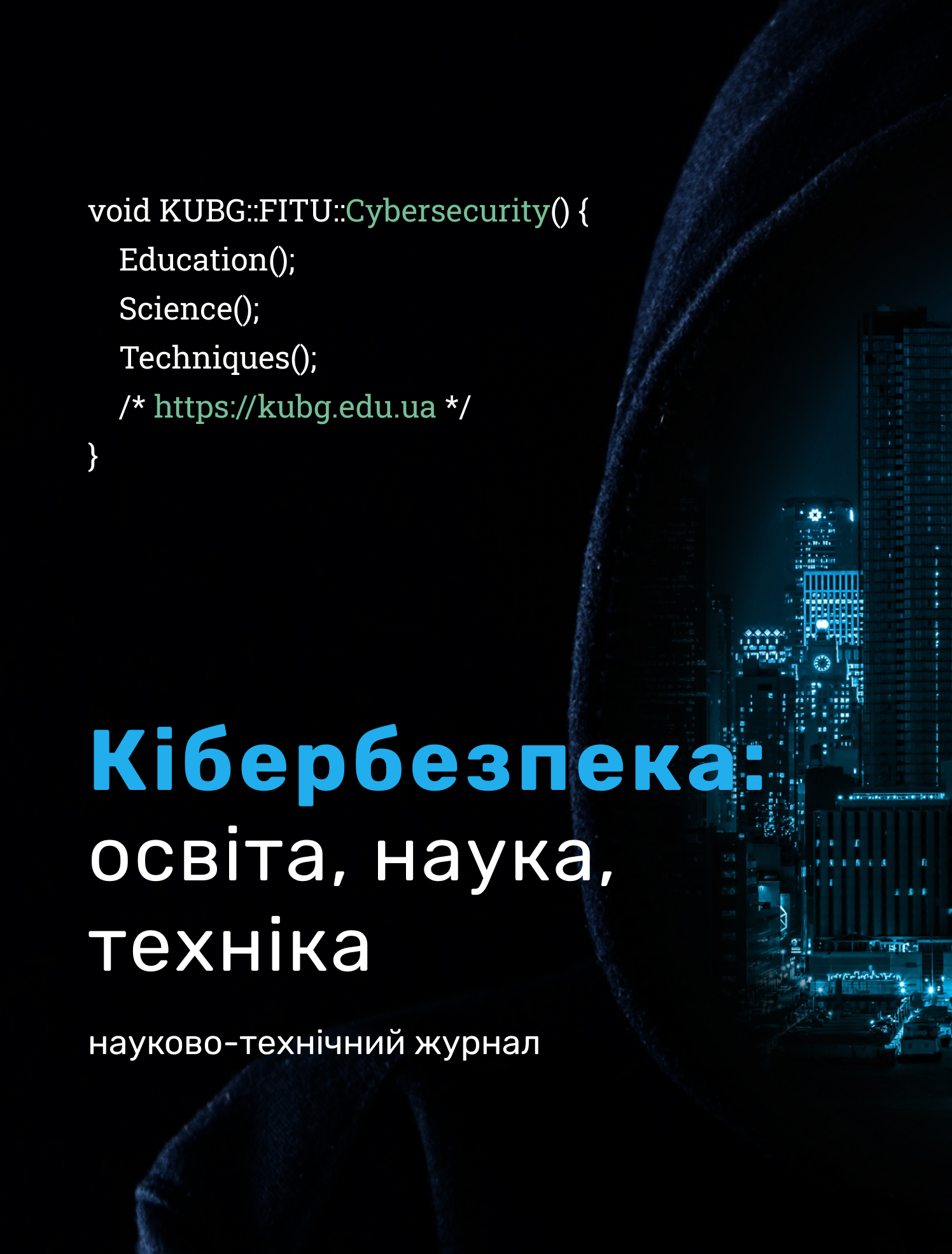ЕФЕКТИВНІСТЬ ПРОГРАМНОГО ЗАБЕЗПЕЧЕННЯ ЩОДО КІБЕРЗАХИСТУ ДЕРЖАВИ
DOI:
https://doi.org/10.28925/2663-4023.2025.30.922Ключові слова:
кіберзахист, ризики, ієрархія цілей, відносна ефективність, алгоритм, метод, захист інформаціїАнотація
У статті розглянуто метод оцінки ефективності програм кіберзахисту (ПКЗ) з урахуванням кібератак та пов’язаних з ними ризиків, що є продовженням попередніх досліджень авторів. Запропонований підхід ґрунтується на модифікації методу цільового динамічного оцінювання програм на заданому часовому інтервалі, який дозволяє враховувати складну структуру взаємозв’язків між цілями, вплив кібератак, ризиків та запізнення у досягненні результатів. Метод передбачає побудову мережевої ієрархії цілей у три етапи: спочатку здійснюється декомпозиція головної цілі згори донизу шляхом визначення підцілей, що безпосередньо впливають на її досягнення, з визначенням їх типу (кількісні, якісні, визначені, невизначені, кваліфікаційні чи порогові); потім — аналіз знизу вгору для встановлення зворотних зв’язків; на третьому етапі до ієрархії інтегруються моделі кібератак та ризиків. Кібератаки моделюються як спеціальні програми, що негативно впливають на цілі, а ризики — через введення індикаторів у вигляді додаткових цілей. Оцінювання ефективності ПКЗ базується на визначенні ступеня впливу реалізації програм (простих і складних) на досягнення головної цілі. У роботі введено поняття миттєвого показника відносної ефективності, що дозволяє аналізувати динаміку ефективності на різних етапах реалізації. Для обчислення ступеня досягнення цілей використовується ітеративний алгоритм моделювання ієрархії, який враховує нелінійність, зворотні зв’язки та часову залежність параметрів. Особливістю методу є можливість оперативного перерахунку ефективності при зміні структури програм. Метод застосовується для оцінки ефективності напрямків реалізації ПКЗ, множин кібератак і ризиків, а також засобів протидії ним. Розроблений підхід може використовуватися не лише в сфері кібербезпеки, а й для аналізу складних цільових програм у технічній, економічній та інших галузях.
Завантаження
Посилання
Kostiuk, Yu. V., Skladannyi, P. M., Bebeshko, B. T., Khorolska, K. V., Rzaieva, S. L., & Vorokhob, M. V. (2025). Information and communication systems security. [Textbook] Kyiv: Borys Grinchenko Kyiv Metropolitan University.
Kostiuk, Yu. V., Skladannyi, P. M., Hulak, H. M., Bebeshko, B. T., Khorolska, K. V., & Rzaieva, S. L. (2025). Information security systems. [Textbook] Kyiv: Borys Grinchenko Kyiv Metropolitan University.
Hulak, H. M., Zhyltsov, O. B., Kyrychok, R. V., Korshun, N. V., & Skladannyi, P. M. (2023). Enterprise information and cyber security. [Textbook] Kyiv: Borys Grinchenko Kyiv Metropolitan University.
Brailovskyi, M. M., Khoroshko, V. O., Koziura, V. D., & Blavatska, N. H. (2023). Software for protecting the state against cyberattacks. Information Protection, 23(4), 184–191.
Laptiev, O. A., Kuzavkov, V. V., & Khoroshko, V. O. (2023). Systems for detecting covert acoustic information interception devices. Kyiv: Millennium. ISBN 978-966-8063-76-7.
Khoroshko, V. O., Shelest, M. Ye., & Tkach, Yu. M. (2020). Multicriteria evaluation of cybersecurity project effectiveness. Technical Sciences and Technologies, 1(19), 141–124.
Totsenko, V. H. (2000). Harmonization and aggregation of expert assessments considering competence in group evaluation of alternatives for decision support. Problems of Control and Informatics, (4), 128–141. https://doi.org/10.15407/pci2000.04.128
Zghurivskyi, M. Z., & Kovalenko, N. I. (2000). Information approach to project risk analysis and management. Problems of Control and Informatics, (4), 146–156. https://doi.org/10.15407/pci2000.04.146
Novosad, V. P., & Seliverstov, R. H. (2008). Methodology of expert evaluation. Kyiv: NAPA.
Ivanenko, O. H., & Lapa, V. H. (2000). Prediction of random processes (3rd ed., rev.). Kyiv: Naukova Dumka. https://doi.org/10.15407/naukova_dumka.2000.ivanenko
Katrenko, A. V., Pasychnyk, V. V., & Pasko, V. P. (2009). Decision-making theory. Kyiv: BHV Publishing Group. https://doi.org/10.15407/bhv2009.katrenko
Veres, O. M. (2010). Decision support technologies. Lviv: Lviv Polytechnic Publishing.
Laptiev, O. A., & Khoroshko, V. O. (2024). Detection, localization, and processing of signals from covert information interception devices. Kyiv: Millennium.
Laptiev, O. A., & Marchenko, V. V. (2025). Using interference to protect information from leakage via radio channel. Modern Information Protection, (1), 89–97. https://doi.org/10.31673/2409-7292.2025.013057
Khoroshko, V., Khokhlachova, Y., Laptiev, O., & Fowad, A. A. (2025). Mathematical apparatus for finding the optimal configuration of a secure communication network with a specified number of subscribers. Informatyka, Automatyka, Pomiary w Gospodarce i Ochronie Środowiska, 15(1), 62–66. https://doi.org/10.35784/iapgos.6406
Laptiev, O., Laptieva, T., & Brailovskyi, M. (2025). Methods of calculating parameters for detecting signals of covert information acquisition devices. Cybersecurity: Education, Science, Technology, 4(28), 575–585. https://doi.org/10.28925/2663-4023.2025.28.812
Al-Dalvash, A., Petchenko, M. V., & Laptiev, O. A. (2025). Method for detecting digital radio signals using differential transformation. Modern Information Protection, (1), 285–291. https://doi.org/10.31673/2409-7292.2025.014329
Kalchuk, I., Laptieva, T., Lukova-Chuiko, N., & Kharkevych, Yu. (2021). Method for building secure data transmission channels using a modified neural network. Information Technology and Security, 9(2), 232–243.
Опубліковано
Як цитувати
Номер
Розділ
Ліцензія
Авторське право (c) 2025 Володимир Хорошко, Олександр Лаптєв, Микола Браіловський, Тетяна Лаптєва, Сергій Лаптєв

Ця робота ліцензується відповідно до Creative Commons Attribution-NonCommercial-ShareAlike 4.0 International License.




